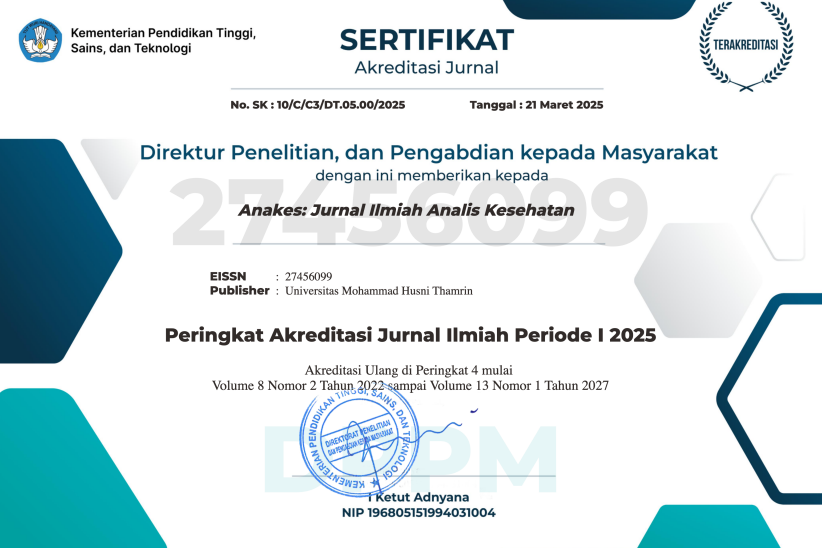Kuantifikasi Gen VDR pada Diabetes Melitus Tipe 2 dengan Metode Real-Time Polymerase Chain Reaction
DOI:
https://doi.org/10.37012/anakes.v7i1.452Abstract
Diabetes melitus (DM) tipe 2 adalah penyakit yang ditandai dengan hiperglikemia akibat resistensi tubuh terhadap efek insulin yang diproduksi oleh sel beta pankreas. Pada lansia terjadi proses menua yang menyebabkan banyak perubahan, Defisiensi vitamin D dapat terjadi pada penderita DM tipe 2 dan mempercepat resistensi insulin. Vitamin D berperan pada imunomodulator yang melindungi terhadap kejadian DM melalui gen Vitamin D Receptor (VDR) yang diekspresikan pada sel penyaji antigen, sel T aktivasi dan sel β pankreas. Jumlah VDR yang ada di dalam tubuh tergantung pada gen VDR yang diekspresikan di dalam sel. Kuantifikasi peningkatan gen VDR pada lansia DM tipe 2 dengan metode Real-Time PCR. Penelitian ini menggunakan metode deskriptif laboratorik. Spesimen terdiri dari darah lansia yang menderita DM tipe 2 dan darah lansia dengan kadar glukosa normal. Ekstraksi DNA dari spesimen darah dengan metode spin kolom kemudian dilakukan amplifikasi menggunakan Real-Time PCR. Hasil Real-Time PCR dianalisis dengan menggunakan perhitungan rasio. Hasil penelitian nilai Ct normal adalah 21, sedangkan pada lansia penderita DM sangat bervariasi dengan nilai Ct paling kecil 15,22 dan nilai Ct paling tinggi 21,61. Disimpulkan terdapat variasi jumlah peningkatan gen VDR pada lansia penderita DM tipe 2.
References
Brown, T. . (2018). Gene Cloning & DNA Analysis. A John Wiley & Sons.
Cheon, C. K., Nam, H. K., Lee, K. H., Kim, S. Y., Song, J. S., &
Kim, C. (2015). Vitamin D receptor gene polymorphisms and type 1 diabetes mellitus in a Korean population. Pediatrics International, 57(5), 870–874. https://doi.org/10.1111/ped.12634
Dowd, D. R., Macdonald, P. N., & Second, C. (2013). Molecular and Cellular Endocrinology Handbook of Immunohistochemistry and in situ Hybridization of Human (Vol. 25).
Geneaid. (2017). Genomic DNA Mini Kit ( Blood / Cultured Cell ).
Hossein-Nezhad, A., Eshaghi, S. M., Maghbooli, Z., Mirzaei, K., Shirzad, M., Curletto, B., & Chen, T. C. (2014). The role of vitamin D deficiency and vitamin D receptor genotypes on the degree of collateralization in patients with suspected coronary artery disease. BioMed Research International, 2014. https://doi.org/10.1155/2014/304250
Indra, T. A., Lydia, A., Purnamasari, D., & Setiati, S. (2017). Asosiasi antara Status Vitamin D 25(Oh)D dengan Albuminuria pada Pasien Diabetes Melitus Tipe 2. Jurnal Penyakit Dalam Indonesia, 4(1), 16. https://doi.org/10.7454/jpdi.v4i1.108
Kementerian Kesehatan RI Badan Penelitian dan Pengembangan. (2018). Hasil Utama Riset Kesehatan Dasar. Kementrian Kesehatan Republik Indonesia, 1–100. https://doi.org/1 Desember 2013
Khairani. (2019). Hari Diabetes Sedunia Tahun 2018. Pusat Data dan Informasi Kementrian Kesehatan RI, 1–8.
Khan H, Kunutsor S, Franco OH, C. R. (2013). Vitamin D, type 2 diabetes and other metabolic outcomes: a systematic review and meta-analysis of prospective studies. Proc Nutr Soc.
Kurniawan, L. B., Bahrun, U., & Darmawaty. (2012). Hubungan Kadar Transaminase terhadap Mortalitas dan Lama Perawatan Pasien Infark Miokard Correlation between Serum Transaminase and Mortality and Length of Hospitalization in Myocardial Infarction Patients. Jurnal Kedokteran Yarsi, 20(1), 29–35.
Lestari, A. A. W. (2011). Resistensi Insulin : Definisi , Mekanisme dan Pemeriksaan Laboratoriumnya. Repositori Unud.Ac.Id, 1(2), 2–3.
Mackawy, A. M. H., & Badawi, M. E. H. (2014). Association of vitamin D and vitamin D receptor gene polymorphisms with chronic inflammation, insulin resistance and metabolic syndrome components in type 2 diabetic Egyptian patients. Meta Gene, 2, 540–556. https://doi.org/10.1016/j.mgene.2014.07.002
Maddocks, S., Jenkins, R., & Pcr, U. (2017). Real-Time Polymerase Chain Reaction Long Noncoding RNAs and Cancer. Gene.
Marinda, F. D., Suwandi, J. F., & Karyus, A. (2016). Tatalaksana Farmakologi Diabetes Melitus Tipe 2 pada Wanita Lansia dengan Kadar Gula Tidak Terkontrol Pharmacologic Management of Diabetes Melitus Type 2 in Elderly Woman with Uncontrolled Blood Glucose. J Medula Unila, 5(2), 7. Diambil dari www.unila.ac
Neelankal John, A., & Jiang, F. X. (2018). An overview of type 2 diabetes and importance of vitamin D3-vitamin D receptor interaction in pancreatic β-cells. Journal of Diabetes and its Complications, 32(4), 429–443. https://doi.org/10.1016/j.jdiacomp.2017.12.002
O’Neill, V., Asani, F. F., Jeffery, T. J., Saccone, D. S., & Bornman, L. (2013). Vitamin D Receptor Gene Expression and Function in a South African Population: Ethnicity, Vitamin D and FokI. PLoS ONE, 8(6). https://doi.org/10.1371/journal.pone.0067663
Pike, J. W., Meyer, M. B., Lee, S. M., Onal, M., & Benkusky, N. A. (2017). The Vitamin D receptor: Contemporary genomic approaches reveal new basic and translational insights. Journal of Clinical Investigation, 127(4), 1146–1154. https://doi.org/10.1172/JCI88887
R Glick, B., Pasternak, J. J., & Patten, C. L. (2010). Molecular Biotechnology. ASM press.
Å tefÃková, K., Spustová, V., KrivoÅ¡Ãková, Z., OkÅ¡a, A., GazdÃková,
K., Fedelešová, V., & Dzúrik, R. (2011). Insulin resistance and vitamin D deficiency in patients with chronic kidney disease stage 2-3. Physiological Research, 60(1), 149–155. https://doi.org/10.33549/physiolres.931814
Suryanto, T., & T, H. A. (2018). Hubungan antara Kadar 25 ( OH ) D 3 dan C-Peptida Berdasarkan Lama Sakit pada Anak dengan Diabetes Melitus Tipe 1 The Correlation between 25 ( OH ) D 3 and C-Peptide Levels Based on Illness Duration in Children with Type 1 Diabetes Mellitus, 30(1), 29–35.
Vural, H. C., & Maltas, E. (2012). RT-qPCR assay on the vitamin D receptor gene in type 2 diabetes and hypertension patients in Turkey. Genetics and molecular research : GMR, 11(1), 582–590. https://doi.org/10.4238/2012.March.14.1
Downloads
Published
How to Cite
Issue
Section
Citation Check
License
Anakes :Â Jurnal Ilmiah Analis Kesehatan allows readers to read, download, copy, distribute, print, search, or link to the full texts of its articles and allow readers to use them for any other lawful purpose. The journal allows the author(s) to hold the copyright without restrictions. Finally, the journal allows the author(s) to retain publishing rights without restrictions Authors are allowed to archive their submitted article in an open access repository Authors are allowed to archive the final published article in an open access repository with an acknowledgment of its initial publication in this journal.

Lisensi Creative Commons Atribusi 4.0 Internasional.











